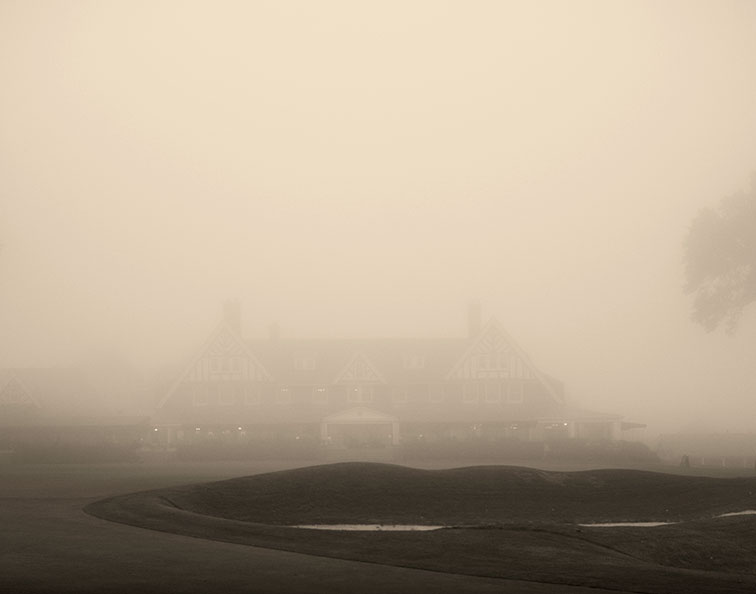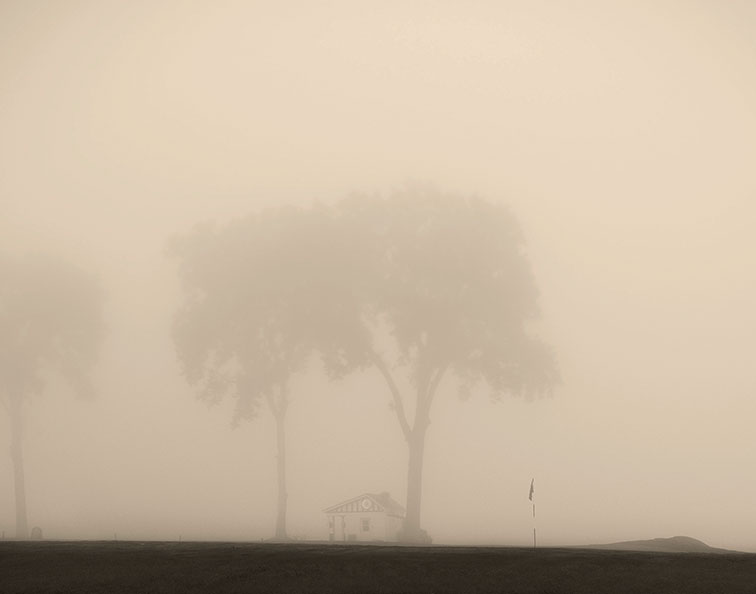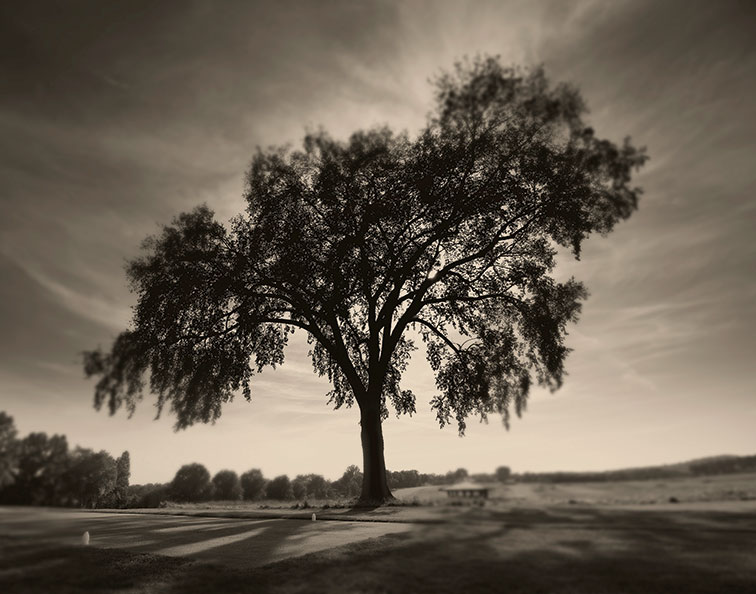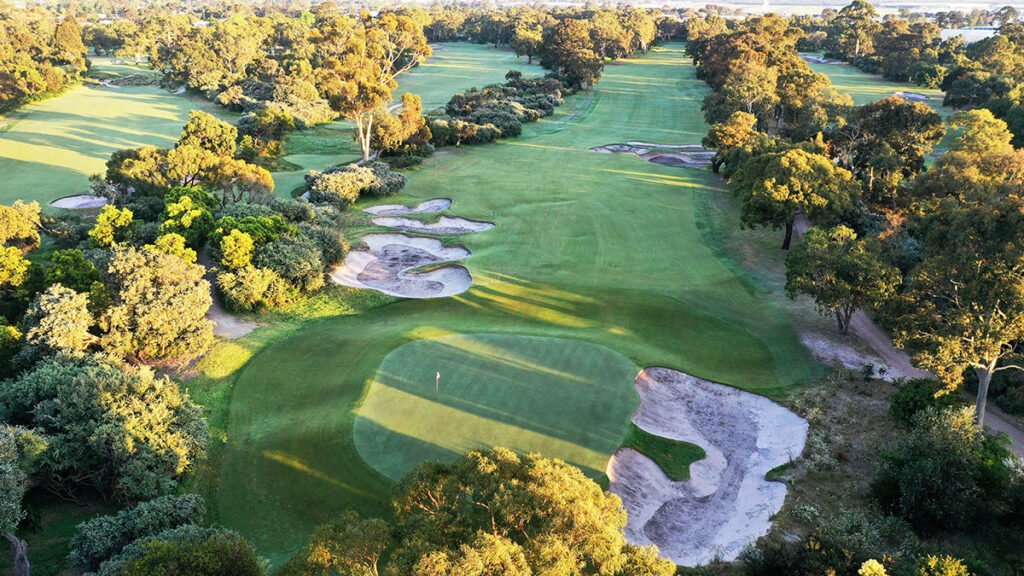WHAT’S the saying? We can’t see the forest for the trees? In the case of Oakmont Country Club, which June 16-19 hosts a record ninth US Open, we can’t see the forest for the lack of trees. The last time the Open visited Oakmont, in 2007, when Angel Cabrera won by a stroke – Tiger Woods missed a 25-foot birdie putt on the final hole, and Jim Furyk bogeyed the 17th after trying to drive the short par 4 – the course had been so clear-cut that we proclaimed Mighty Oakmont had returned to its roots. “Its one-of-a-kind character has been reclaimed, restored and revitalised by astonishing tree removal,” we wrote. “It’s back to the barren look and brazen playing characteristics it had when it hosted its first US Open, in 1927.”
Back then we reported more than 5,000 trees had been removed along Oakmont’s fairways, widening the panoramas and highlighting ferocious bunkering and deep drainage ditches that had previously been obscured beneath foliage. John Zimmers Jr, Oakmont’s course superintendent, now confirms that crews actually removed about 7,000 trees before the 2007 Open. But here’s a surprising footnote: Since 2007, Zimmers and his team have removed another 7,500 trees.

These days, from the veranda on Oakmont’s clubhouse, one can see some portion of every hole, a view all the way to the flag of the hilltop third green at the far northeastern corner of the property. What’s more, if you didn’t know the Pennsylvania Turnpike existed – it separates holes 2 through 8 from the rest of the course – you wouldn’t sense it from today’s view. Because the turnpike is recessed, it’s merely a horizontal shadow, barely noticeable. When dense rows of trees were on either side, they had highlighted its existence.
In the process of chain-sawing away 60 years of growth, Oakmont’s dramatic topography has been fully revealed. Without a backdrop, the front-to-back slopes of the first, sixth and 10th greens are obvious. (For this year’s US Open, the back of the sixth green has been expanded, providing new pin placements, and at 12 two bunkers were removed and one was expanded. Those are the only major architectural changes to the course, which will play at par 70 and 6,601 metres, down 10m from 2007.) Elsewhere, hills look steeper and distances more deceiving. The downhill, par-5 12th now seems like it should be reachable in two even at 610m, though it’s not the longest hole in US Open history – the 16th at Olympic Club in San Francisco beats it by 2m.

When Oakmont Leads, Others Follow
Why does this tree removal matter? Because Oakmont is the standard for US championship golf. Besides US Opens, it has been the site of five US Amateurs, three PGA Championships and two US Women’s Opens. Much of what happens at Oakmont affects the game. After all, it had fast greens decades before they became fashionable. Those swift greens caused the Stimpmeter to be created in the late 1930s, and whether that’s a positive or negative, the Stimpmeter measurements of green speeds are here to stay at many, many clubs. For this year’s Open, the United States Golf Association wants Oakmont’s greens rolling at 14 feet on a Stimpmeter, the same speed they measured in 2007.
A near-universal high regard for Oakmont makes controversy acceptable. In 2007, the USGA played the par-3 eighth from a new back tee, stretching the hole to as much as 274m for the final round. (After acing the hole in a practice round at 263m, Trevor Immelman was asked if he saw the ball go into the hole and replied, “We couldn’t see that far.”)
At nearly any other club, a 274m par 3 would be considered a joke if not a travesty, but because it happened at Oakmont, a number of golf architects subsequently embraced the idea of an extremely long championship tee on a one-shot hole to require champion players to use a metal wood to reach the green. Oakmont gave architects cover to fight technology with an extreme measure.
The tree-removal program at Oakmont might well be this storied club’s finest contribution to the game of golf. It reversed a trend it had helped start in the 1950s, the “beautification” of inland American courses by a sanctioned program of constant and misguided planting of trees funded by green committees and membership drives.
Thumb through Oakmont’s tournament program from 1962 – the year 22-year-old Jack Nicklaus won his first professional Major, indeed his first professional tournament, in a playoff over Arnold Palmer – and what jumps out are aerial photos showing hole after hole dotted with saplings. Plus seven advertisements for tree nurseries. It’s no wonder that the USGA subsequently selected Minnesota’s Hazeltine National for the 1970 US Open, despite cries that the eight-year-old course looked far too immature to host a national championship. Hazeltine at that time didn’t look any younger than Oakmont. Hazeltine, site of the 2016 Ryder Cup September 30 – October 2, now has towering hardwoods on many holes.
Oakmont was leafy green for US Opens in 1973, 1983 and 1994, but then the club stopped planting trees and started removing them in bunches. Quietly, at first, and strictly to improve the health of turf normally blanketed in shade. Then-superintendent Mark Kuhns, with the approval of his 18-member green committee, had a crew assemble at 4 am. Under truck lights, they’d set down tarps, chop down a tree, cut it up, haul it off, grind the stump to ground level, vacuum up wood chips and leaves, then slap sod over it. By dawn, they’d be finished, and golfers playing the hole were none the wiser. Kuhns removed almost 500 trees that way until one day a caddie pointed out a gaping void to an influential club member.
It quickly became a contentious issue among the membership. There were meetings, threatened petitions and the spectre of a lawsuit. Some called Kuhns“The Butcher of Oakmont” to his face. But the green-committee members doubled down, campaigning that Oakmont’s trees should be removed because they were contrary to the original concept of founder H.C. Fownes. Among the evidence they presented: a 1938 Grantland Rice article, which referenced Oakmont as a links as famed as St Andrews; a 1949 aerial of Oakmont showing scant trees; and a 1994 Golf Digest article critical of the prettification of the course (“Has the Old Bully Lost its Punch?” June 1994).
Eventually a majority of the members came around, but although they grudgingly allowed Kuhns to continue some tree removal, they refused to allocate additional funds. He had to squeeze the expenses from his normal operating budget, and as a result other areas of the course suffered a bit.
In late 1999, Kuhns moved to Baltusrol, site of this year’s US PGA Championship, and Zimmers took his place. He stepped up the tree removal, tying many expenses to club capital projects to cover costs. By 2002, the effects were so dramatic it warranted a follow-up story in Golf Digest (“Mission: Unpopular” October 2002). The story quoted Tom Meeks, then the USGA’s senior director of rules and competition: “If any club thinks they would be hurting themselves by cutting down a few trees, go look at Oakmont and see what they’ve done. They are the leaders in the clubhouse.”

An Example Of Sustainability
For this year’s Open, the USGA plans to highlight Oakmont’s tree-removal program as another facet of sustainability. After all, instead of replacing the trees with lush, maintained turf that would demand additional water and chemicals, many areas of former forest are now covered in tall fescues that need little maintenance and turn bronze and wavy in later summer. (Trivia note: Though other bunkers at Oakmont are edged by a bluegrass-ryegrass mix of maintained rough, the huge Church Pews bunker between the third and fourth holes has each pew planted in unmaintained fescue, because the club believes the famed hazard deserved a distinctive look.)
Other grand courses in the US have removed pointless trees in the past decade and a half, and some were chopping and pruning even before Oakmont’s extensive clear-cutting became public. But had Oakmont not succeeded in its effort in such a dramatic, visual manner, and had that effort not been well-received (finally) by its membership and those who study and promote golf-course architecture, it’s doubtful similar programs would have occurred at such prominent clubs as Olympic and Oak Hill. The nearly treeless Oakmont is an extreme example, a total reversal of the sentiment that trees belong on a golf course, because its heritage didn’t rely on aerial hazards whatsoever.
Other clubs are more content to retain some trees for safety or aesthetic purposes, which is fine. But the lesson of Oakmont is that every club should re-examine its landscape. Most would find many of their trees superfluous and, as at Oakmont, the character of their layouts would improve once those trees are removed.
US Open At Oakmont: The Numbers You Need To Know
2007 US Open Top Finishes
• Angel Cabrera 69-71-76-69—285 (+5)
• Jim Furyk 71-75-70-70—286 (+6)
• Tiger Woods 71-74-69-72—286 (+6)
• Niclas Fasth 71-71-75-70—287 (+7)
• David Toms 72-72-73-72—289 (+9)
• Bubba Watson 70-71-74-74—289 (+9)
• Nick Dougherty 68-77-74-71—290 (+10)
• Scott Verplank 73-71-74-72—290 (+10)
• Jerry Kelly 74-71-73-72—290 (+10)
• Justin Rose 71-71-73-76—291 (+11)
• Stephen Ames 73-69-73-76—291 (+11)
• Paul Casey 77-66-72-76—291 (+11)
Other Selected Finishes
• Brandt Snedeker 71-73-77-74—295 (+15)
• Ian Poulter 72-77-72-77—298 (+18)
• Zach Johnson 76-74-76-74—300 (+20)
• Ernie Els 73-76-74-78—301 (+21)
• Jason Dufner 71-75-79-80—305 (+25)
Among Those Missing The Cut
• Phil Mickelson (74-77)
• Sergio Garcia (79-75)
• Henrik Stenson (79-76)
Leaders By Rounds
• Round 1, Nick Dougherty, -2
• Round 2, Angel Cabrera, E
• Round 3, Aaron Baddeley, +2
• Round 4, Cabrera, +5
Rounds In The 80s
Aaron Baddeley led Tiger Woods by two strokes entering the final round but triple-bogeyed the first hole and finished T-13 after an 80, one of 60 rounds in the 80s in 2007. The breakdown in scoring: 80 (17 times), 81 (15), 82 (8), 83 (6), 84 (5), 85 (4), 86 (3), 87 (1), 89 (1).
2007 Scoring Stats
The field scoring average was 75.72. Tour pros tend to beat up par 5s, but the 557m fourth (5.06) and the 610m 12th (5.41) both played over par. The easiest hole was the 327m 14th (4.05), and the hardest was the 442m 18th (4.60).
2007 Stat Leaders
Driving distance, George McNeill, 285m; fairways hit, Fred Funk, 41; greens in regulation, Tiger Woods, 49; putts, Niclas Fasth, 114; birdies, Geoff Ogilvy, 14; bogeys, McNeill, 26; double bogeys/others, Jason Dufner, 8/0.
Oakmont’s Other US Opens
1994 After finishing at five-under-par 279, Ernie Els won a 20-hole playoff. Els and Loren Roberts shot 74s to eliminate Colin Montgomerie (78) before Els’ birdie on the second hole of sudden death.
1983 Larry Nelson holed a 62-foot putt after play resumed Monday morning and won at four-under 280.
1973 Johnny Miller’s final-round 63 put his winning total at five-under 279.
1962 Jack Nicklaus and Arnold Palmer finished at one-under 283 before Nicklaus won the playoff, 71-74.
1953 Ben Hogan won $US5,000 with a total of five-under 283.
1935 Sam Parks Jr. won at 11-over 299.
1927 Tommy Armour and Harry Cooper tied at 13-over 301 before Armour won the playoff, 76-79.
Oakmont’s US Women’s Opens
2010 Paula Creamer shot a final-round 69 to win by four strokes at three-under 281.
1992 Patty Sheehan and Juli Inkster tied at four-under 280 before Sheehan won the playoff, 72-74.
Oakmont’s US Amateurs
2003 Australia’s Nick Flanagan beat Casey Wittenberg on the 37th hole.
1969 Steve Melnyk won by five strokes in stroke play (286).
1938 Willie Turnesa beat B. Patrick Abbott, 8&7.
1925 Bobby Jones beat Watts Gunn, 8&7.
1919 S. Davidson Herron defeated Jones, 5&4.
Oakmont’s PGA Championships
1978 After tying Jerry Pate and Tom Watson at eight-under 274, John Mahaffey won with a birdie on the second playoff hole.
1951 Sam Snead beat Walter Burkemo, 7&6.
1922 Gene Sarazen beat Emmet French, 4&3.
Future US Open Venues
2017 Erin Hills (Wisconsin)
2018 Shinnecock Hills G.C. / Southampton, New York
2019 Pebble Beach Golf Links
2020 Winged Foot G.C. / Mamaroneck, New York
2021 Torrey Pines G. Cse. (South) / La Jolla, California
2022 The Country Club / Brookline, Massachusetts
2023 Los Angeles Country Club (North)
2024 Pinehurst Resort




